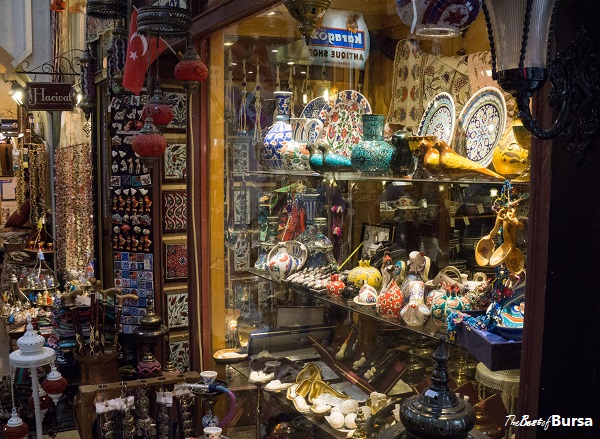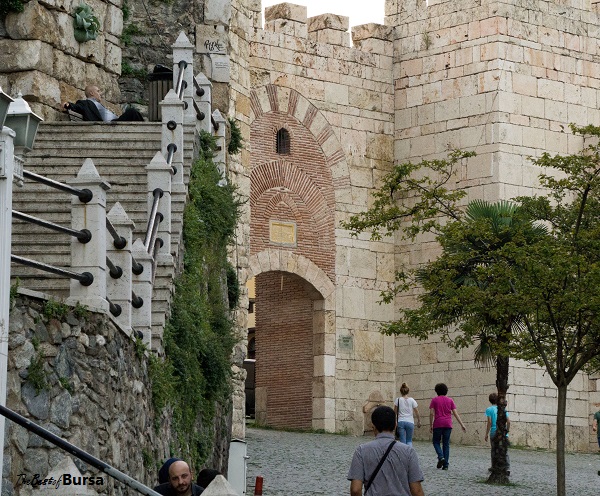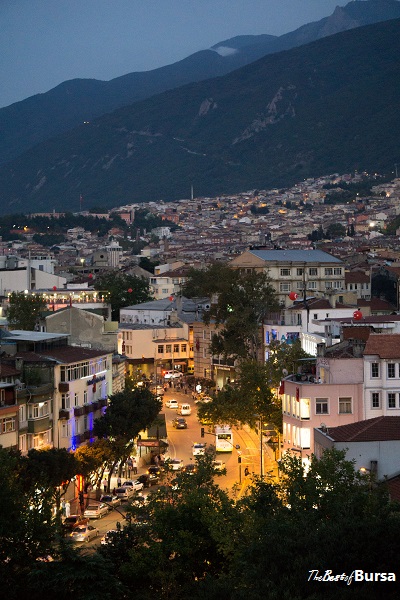>>>Download this article for offline viewing using the GPSMyCity app! Click here.
In my opinion, Bursa deserves far more than one day of your time. You could spend days exploring the city’s nooks and alleys and digging into the rich culture and history of this area. But if you have no other choice, it is possible to visit many of the key historical and cultural sites in the city center in a one-day walking tour. This little self-guided Bursa tour outline will help you do just that. Use it as a complement to your favorite Bursa guidebook.
Historical Context
Here’s a super-brief historical background to this tour: Bursa was captured from the Byzantines in 1326 by Orhan Gazi, son of Ottoman founder Osman Gazi, who then made Bursa the first official capital city of the Ottoman Empire. In 1326, Bursa was a walled city situated on an Uludağ foothill surrounded by a handful of small villages. The remains of the original citadel can still be explored in the Hisar area around Tophane, on the hill just above the city center. The first Ottoman sultans, six of whom are buried in Bursa, left an indelible mark on the city. Many of the city’s historical treasures revolve around these early sultans, who aggressively expanded the city beyond the Byzantine walls and into the surrounding plains where the city center lies today. On this tour, you will visit mosques, tombs, bazaars, museums, and other sites that stem from the city’s deep Ottoman heritage, many of which in 2014 were recognized by UNESCO as being the birthplace of the Ottoman Empire.
Starting This Bursa Tour
This tour starts on the east end of the city center at the Emirsultan Külliyesi (social and religious complex) and ends at the Muradiye Külliyesi. That’s a full day of walking! I would suggest giving yourself a good 6-8 hours to complete this tour, longer if you like to linger in shops, take frequent tea breaks, and savor the rich sounds, smells, and tastes of Turkish culture. You’ll also want to make sure you have a Smart BursaKart (public transportation pass, also called BuKart) with you as you’ll take at least two trams and one bus if you follow this tour exactly.
I propose that your Bursa walking tour starts at the Emirsultan Külliyesi. However, by doing so, you will miss seeing the Yıldırım Külliyesi of Sultan Beyazid I (1360-1403), one of the important UNESCO sites in the city. I did this because this tour already includes four of the city’s külliyes and the Yıldırım Külliyesi does not provide enough added interest (in my opinion) to justify the time and walking distance that it would add to the tour. If visiting the Yıldırım Külliyesi is important to you, however, you can either include it at the start of the tour or you can visit Yıldırım Külliyesi in place of Emirsultan Külliyesi. If you choose to start your tour at Yıldırım Külliyesi, take the metro east from the city center to the Gökdere station and walk through the Gökdere bazaar and up the hill to the large mosque and social complex.
A Note About Külliyes
A külliye is an Ottoman-era religious and social complex that includes a mosque, a tomb, and social buildings such as a public bath house (hamam), a soup kitchen, a madrasah (religious school), a health clinic, a commercial area, a park, a cemetery, and public fountains. Usually surrounded by residential neighborhoods, Bursa’s külliyes became the model for urban planning and development throughout the Ottoman Empire for centuries.
Regarding mosques, on this tour you will have the opportunity to visit a number of important and historical mosques in Bursa. Do not be afraid to step inside and take a look around. Historical mosques in Bursa are generally open and welcoming to tourists. Just keep in mind that shoes cannot be worn into a mosque, men must wear long pants, and women must cover their heads with a scarf and wear modest clothing.
Before you begin, please open up and review this MAP of the tour.
Now, eat a good breakfast, put on your walking shoes, grab your camera, and head out for a good day of history, fun, and culture…
Step 1: Let’s start the tour by going to the Emirsultan Külliyesi. A taxi will take you there directly if you prefer. Or, assuming you’re starting from the city center, you can get there by taking the green and white T3 tramline eastward. Catch the T3 tram at Zafer Plaza or at stops along Cumhuriyet Caddesi. Get off the tram at the Emirsultan Mezarliği (cemetery) tram stop.
Step 2: Once off the tram, walk up the very steep hill through the green and peaceful cemetery until you reach the mosque. Don’t worry; this is the steepest hill you’ll ascend on this tour. (If you’re averse to walking steep hills, you can also grab a cab at the tram stop.) Emir Sultan (1368-1430) was never actually a sultan; rather, he was a renowned scholar and advisor to Sultan Bayezid I (who was, in fact, a sultan). His complex is not original, having been destroyed and rebuilt through the years. It is, however, quite beautiful and unique in that it has a large central courtyard separating the mosque from the tombs, which you can visit. The large Emirsultan square is lovely and includes a health center, a hamam, and a few cafés, as well as a really nice lookout over the east end of the city.
Step 3: From Emirsultan, walk down Emirsultan Caddesi to the Yeşil Külliyesi on the east end of the city center. At Yeşil, visit the tomb and mosque of Çelebi Sultan Mehmet (1381-1421), the fifth Ottoman sultan. The Yeşil Tomb is particularly beautiful with its intricate blue-green interior and exterior tile work. While you’re at Yeşil, grab a cup of tea in the Hünkar Café overlooking the Yıldırım district. Then visit Yunus Vurmaz’s Anadolu Gift Shop and be sure to ask him to show you his handmade rug collection. After that, walk through the interesting and peaceful Turkish-Islamic Arts Museum in the 15th century madrasah. The Yeşil Külliyesi is probably my favorite area in the city center.
Step 4: From the madrasah walk down the hill on Yeşil Sokak and take a left on Boyacı Sokak and cross the busy Gökdere Bulvarı using the pedestrian overpass. On the west side of Gökdere Bulvarı, take a left and walk up the street to the covered yellow Irgandı Bridge (köprüsü). Built in 1442, the bridge was transformed in recent years into rows of booths and shops selling locally produced handcrafts. Take a slow stroll across the bridge, window shopping in the quaint artisans’ shops that line the bridge. Look for ceramics, ebru art, filography, wool clothing, books, calligraphy, and metal crafts.
Step 5: Once you cross Irgandı Bridge, take a left on Selçuk Sokak and a right on Kayhan Sokak. Walk until you come to the metal shops and köfte grills of Kayhan Pazarı and Demirciler Pazarı. Exploring the parallel streets and bazaars on either side of Kayhan Caddesi, you’ll see an eclectic mix of appliance and furniture shops, working blacksmith shops, leather shops, and köfte restaurants. If you’re hungry, try the köfte (it’s excellent). Eventually turn west on Kayhan Caddesi. Work your way westward toward the main bazaar complex.
Step 6: Cross Īnönü Caddesi (using the pedestrian underpass) and slowly walk your way through the long winding central bazaar complex, where goods of all kinds can be purchased. The bazaar consists of parallel streets and a number of large, two-story, open-air stone buildings called hans that are interconnected by innumerable alleys and side streets. I recommend having a cup of tea in the quiet and hard-to-find Çukur Han. When you get to Koza Han, turn left and enter the han. Koza Han was built in 1491 by Beyazid II as a center for the city’s silk industry, and you can still purchase silk goods there today. In the han, search for a silk scarf or other souvenirs on the two levels of shops and grab an ice cream in the courtyard. If you haven’t eaten yet, try the Īskender kebab at the famous Īskender restaurant in the Inner Koza Han. When you’re ready, exit Koza Han at the south gate on the upper level (opposite of where you entered).
Step 7: Exiting Koza Han, you’ll enter Orhan Bey Square. Consisting of Emir Han, Orhan Gazi Mosque, and the surrounding bazaar, this area comprises the Orhan Gazi Külliyesi. Take some photos and mill about the lovely central fountain. Just to the east is the Old City Hall with its unique European architecture. Take a stroll around the city hall and enjoy the fountain and shops behind the building. If there is an exhibit showing at the Ressam Şefik Bursalı Art Gallery, take a peek inside. Also, visit the city bookstore and peruse its offerings on the city’s history and culture.
Step 8: Slowly walk westward back through Orhan Gazi Square toward Ulu Cami’i (Grand Mosque). Before you get to Ulu Cami’i, take a right down the narrow side street and step down into the Eski Aynalı Çarsı, a former bath house, where you’ll find some neat antique and souvenir shops. Be sure to stop by Mr. Çelikkol’s Karagöz Antique Shop and see his collection of Karagöz shadow puppets. If Mr. Çelikkol is there, he’ll even be happy to give you a short little puppet show if you ask.
Step 9: Walk back out of Eski Aynalı Çarsi the way you came in and step inside the remarkable Ulu Cami’i and take a look around. Designed in the Seljuk style, the building has 20 domes and two prominent minarets and its interior is impressively decorated with calligraphic inscriptions. Built by Beyazid I in 1399, Ulu Cami’i is one of the most important mosques in Islam.
Step 10: Exiting Ulu Cami’i, walk down Ulu Cami’i Cadessi on the west side of the mosque back toward the bazaar. Take a left on Cumhuriyet Cadessi and work your way toward Cemal Nadir Caddesi, taking in the sights and smells of the bustling bazaar along the way.
Step 11: Cross the busy Cemal Nadir Caddesi and slowly work your way up the hill through Balibey Han, drinking tea and window shopping as desired. Balibey Han is unique among Bursa’s hans as instead of being a two-story structure, it is a three-sided, three-story structure built into the side of the hill. Built in the 15th century under Mehmet II, the han is now home to a number of local artisans in whose shops you can find some fantastic handiwork for sale.
Step 12: Exiting at the top of Balibey Han, cross the street and walk through the prominent stone Hisar Kapısı (Castle Gate, also called Sultan Gate). You are now in the pre-Ottoman citadel, the oldest part of Bursa. Walking on through the gate, turn left on Kavaklı Caddesi and walk the length of the street, enjoying the sights of this peaceful and old Ottoman neighborhood. Near the end of Kavaklı Caddesi, go left on Üftade Sokak and stroll to the Üftade Mosque and Tomb. Behind the mosque from the top of the old city wall, see some lovely views of the mountainside Pinarbaşı district, one of the oldest neighborhoods in Bursa. After you’ve seen enough of the view, walk back the way you came on Üftade Sokak and Kavaklı Caddesi. Walk all the way to the end of Kavaklı Caddesi until you reach Tophane Park.
Step 13: Enter through the iron gates of Tophane Park and visit the tombs of Osman Gazi (1258-1326) and Orhan Gazi (1281-1362), as well as the Tophane clock tower. In Byzantine times, this area was a monastery, but during the Ottoman Empire this area was used as an armory (tophane means “cannonball house”). Take a walk in the park and enjoy the view of the city center from the edge of the cliff. If you need a rest, sit down for a cup of tea at the lovely Sümbüllü Bahçe Konağı, the yellow building just below the tombs overlooking the city center.
Step 14: From Tophane, save your feet and grab a bus to Muradiye Külliyesi. Take any one of bus numbers 19/E, 3/C, 96, B/38, E/2, or E/12 heading westward away from the city center. Get off at the Muradiye or Murat Hamami stop. Explore Muradiye Külliyesi, an extensive complex that includes tombs, a mosque, a madrasah, and parks in honor of Sultan Murat II (1404-1451), the fourth Ottoman king. Recently reconstructed, the complex is quite beautiful. Across the park, stop in to explore the small but nicely done 17th Century Ottoman House Museum. A half-block down the street, visit the Uluumay Ottoman Clothing and Jewelry Museum, a nice collection housed in a lovely 15th century madrasah.
A Choice: At this point in the tour, you have a choice to make. You can hop on a bus to Çekirge and visit the old and interesting Çekirge Square, Hüdavendigar Külliyesi, and Eski Kaplıca Hamamı. This is a highly recommended activity at some point in your stay in Bursa, and if you still have energy for this you can easily get there from Muradiye by bus or taxi. However, I’m going to assume that by now it’s getting late in the day and your feet are a bit tired, so the next steps in this Bursa tour have you heading back toward the city center.
Step 16: Assuming you’ve chosen to not go on to Çekirge, from Muradiye walk down 2. Murat Caddesi until you come to Altıparmak Caddesi. Stop for a moment to take a look at the Swimming Stones that supposedly represent Karagöz and Hacivat, the famous local shadow puppet characters. Walk up Altıparmak eastward toward the city center (or hop on the red T1 tramway or any bus going east). Toward the east end of Altıparmak on your right, at Çatalfırın, you’ll see the famous Arap Şükrü alley. If it’s around dinner time and you’re hungry, take a seat at one of the many seafood restaurants in the alley and try the local grilled fish while listening to roving bands play live traditional Turkish music.
Step 17: Later that night, if you still have any energy left, end your day at one of the many cafés along Atatürk Caddesi for a nightcap and some live local music. Hop back on the red T1 tram and take it to the Heykel area. Or walk back up to Tophane for a nighttime glimpse of the city center. Sip a cup of tea with the satisfaction that you’ve just had quite a day seeing some of Bursa’s essential sights and experiencing its rich cultural heritage.
Notes on the One-Day Bursa Tour
- This tour includes a lot of walking! Some of the walking is on uneven surfaces (e.g. cobblestone streets) and on steep inclines or descents. You need to be aware of your own physical limitations and plan your tour accordingly. For this reason, I would also not recommend this tour for small children.
- As written, this tour begins on the east end of the city center and has you working your way westward. However, it is possible to reverse this tour or start it anywhere in the middle.
- If you would like to shorten this tour, or if you simply prefer touring at a slower pace, I recommend starting at Yeşil Külliyesi and ending at Tophane. Doing so will keep you in the city center and still give you plenty of neat things to see and experience.
- As mentioned before, you’ll probably want a BursaKart (BuKart), the public transportation card. A BuKart allows you to ride city buses, trams, and metros. Purchase your BuKart using the automated kiosks at any metro station.
- This tour is meant to be complimented by your favorite Bursa guidebook. If you don’t have a Bursa guidebook, I suggest you visit one of the city-run bookstores at Koza Han, Kent Müzesi, or Orhan Bey Square, or the tourist information booth next to Ulu Cami’i along Atatürk Caddesi. Guidebooks are available in multiple languages.
- If you do have more than one day to spend in Bursa, please see our recommended Day Guides.














superbly presented and laid out
Thanks, Alan. It’s a full day of walking, but it offers a lot of neat things to see and experience.
This is simply a Magical city that deserves at least a 3-full-day visit. Superb effort though
Thank you for the encouragement, Vinicius! I agree, Bursa deserves more than a day!